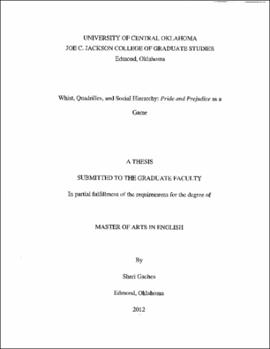| dc.contributor.advisor | Lewis, Gladys S., 1933- | |
| dc.contributor.author | Gaches, Sheri | |
| dc.date.accessioned | 2020-05-26T20:39:11Z | |
| dc.date.available | 2020-05-26T20:39:11Z | |
| dc.date.issued | 2012 | |
| dc.identifier.other | (AlmaMMSId)9978443685202196 | |
| dc.identifier.uri | https://hdl.handle.net/11244/324704 | |
| dc.description.abstract | Jane Austen begins her novel Pride and prejudice by informing readers that what they are about to read is a story about competition. Throughout the novel, Austen's audience becomes aware of the elements of competition in her work, such as a motif of card games, expression of a battle on the dance floor through the rules of nineteenth century dances, and the limiting factors within the rules of social order. Such plot in a novel opens the door for game theory application and analysis of characters, scenes, and plot. By using game theory as a focal point of competition, as well as for sociological, psychological, and historical analysis, readers gain a better understanding of Jane Austen's Pride and prejudice and form an educated opinion of the storyline, the characters, and the game itself, specifically who wins and who loses.--Abstract. | |
| dc.rights | All rights reserved by the author, who has granted UCO Chambers Library the non-exclusive right to share this material in its online repositories. Contact UCO Chambers Library's Digital Initiatives Working Group at diwg@uco.edu for the permission policy on the use, reproduction or distribution of this material. | |
| dc.subject.lcsh | Game theory | |
| dc.subject.lcsh | Literature | |
| dc.title | Whist, quadrilles and social hierarchy : Pride and prejudice as a game. | |
| dc.type | Academic theses | |
| dc.contributor.committeeMember | Bolf-Beliveau, Laura | |
| dc.contributor.committeeMember | Petete, Timothy | |
| dc.thesis.degree | M.A., English | |
| dc.identifier.oclc | (OCoLC)ocn835665041 | |
| uco.group | UCO - Graduate Works and Theses::UCO - Theses | |
| thesis.degree.grantor | Jackson College of Graduate Studies | |
